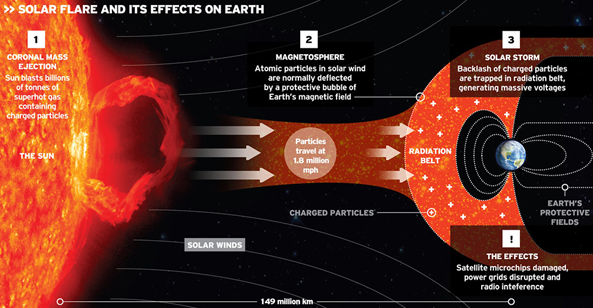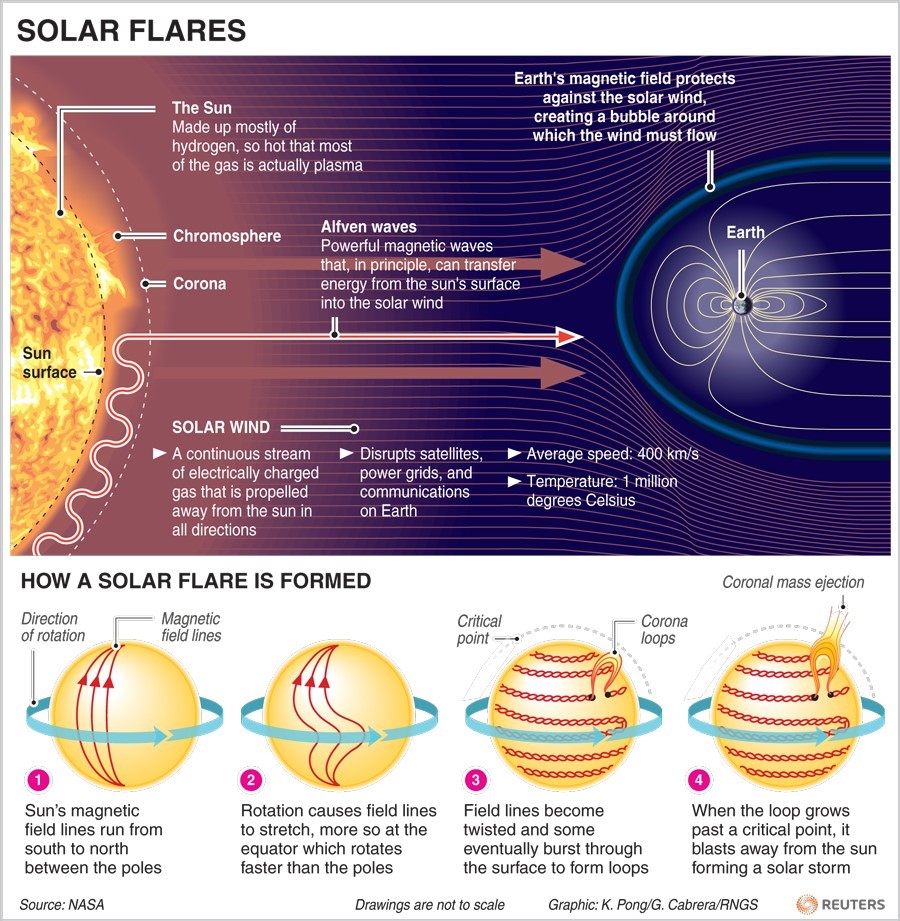Description

Disclaimer: Copyright infringement not intended.
Context
- The High Energy L1 OrbitingX-ray Spectrometer (HEL1OS) payload, on board the Aditya-L1 spacecraft, has captured the first glimpse of solar flares.
Details
About Solar Flares
- A solar flare is an intense localized eruption of electromagnetic radiation in the Sun's atmosphere.
- Flares occur in active regions and are often, but not always, accompanied by coronal mass ejections, solar particle events, and other solar phenomena.
- Solar flares occur in a power-law spectrum of magnitudes; an energy release of typically 1020 joules of energy suffices to produce a clearly observable event, while a major event can emit up to 1025 joules.
- Solar flares affect all layers of the solar atmosphere (photosphere, chromosphere, and corona).
- The plasma medium is heated to tens of millions of kelvins, while electrons, protons, and heavier ions are accelerated to near the speed of light.
- Flares produce electromagnetic radiation across the electromagnetic spectrum at all wavelengths, from radio waves to gamma rays.
- Most of the energy is spread over frequencies outside the visual range; the majority of the flares are not visible to the naked eye and must be observed with special instruments.
- Flares occur in active regions often around sunspots, where intense magnetic fields penetrate the photosphere to link the corona to the solar interior.
- Flares are powered by the sudden release of magnetic energy stored in the corona.
- The same energy releases may produce coronal mass ejections (CMEs), although the relationship between CMEs and flares is still not well understood.
- The frequency of occurrence of solar flares varies with the 11-year solar cycle.
- It can range from several per day during solar maximum to less than one every week during solar minimum.
- Additionally, more powerful flares are less frequent than weaker ones.

Impact of Solar Flares and CMEs on Earth
Not all solar flares reach Earth, but solar flares/storms, solar energetic particles (SEPs), high-speed solar winds, and coronal mass ejections (CMEs) that come close can impact space weather in near-Earth space and the upper atmosphere.
- Space-dependent services: Solar storms can hit operations of space-dependent services like global positioning systems (GPS), radio, and satellite communications.
- Radio communication: Geomagnetic storms interfere with high-frequency radio communications and GPS navigation systems.
- Magnetosphere: CMEs, with ejectiles loaded with matter traveling at millions of miles an hour, can potentially create disturbances in the magnetosphere, the protective shield surrounding the Earth.
- Astronauts: Astronauts on spacewalks face health risks from possible exposure to solar radiation outside the Earth’s protective atmosphere.
- Other: Aircraft flights, power grids, and space exploration programs are vulnerable.
Categories
- There are five categories of solar flare according to their brightness in the x-ray wavelengths which include A, B, C, M, and X; each class is at least ten times more potent than the one before it.
- X-class Flares (Big): They are major events that can trigger radio blackouts around the whole world and long-lasting radiation storms in the upper atmosphere.
- M-class Flares (Medium-Sized): They generally cause brief radio blackouts that affect Earth's polar regions. Minor radiation storms sometimes follow an M-class flare.
- C-class Flares: Compared to X- and M-class events, C-class flares are small with few noticeable consequences here on Earth.
- The smallest ones are A-class (near background levels), followed by other flares.
|
NOTE
Solar flares are different from Coronal Mass Ejections' (CMEs), which were once thought to be initiated by solar flares.
CMEs are huge bubbles of gas threaded with magnetic field lines that are ejected from the Sun over the course of several hours. Although some are accompanied by flares, it is now known that most CMEs are not associated with flares.
|
.jpg)
|
PRACTICE QUESTION
Solar flares are natural phenomena with significant implications for Earth and its technological infrastructure. Discuss the causes and consequences of solar flares and the measures that can be taken to mitigate their potential impact. How can international cooperation enhance preparedness for solar flare events?(250 words)
|












